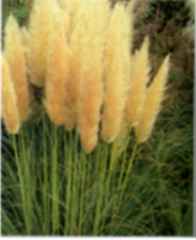|
|
 |
|
|
 |
One of the reasons ornamental grasses are so popular is because they are very low maintenance and grow in just about any sunny climate. Now that Christmas is upon us, relax and wrap your presents. You need not do anything to your grasses. In fact all of your past maintenance should have been done late last February.
Ornamental grasses are "low fertility" meaning that they like little or no fertilizer. Any fertilization should be done with a slow release fertilizer as they hit high gear in their growing season. In our region, this growth period would be in April. Too much fertilizer can damage grasses, especially in the late fall when the freeze could hurt new growth stimulated by late fertilization.
The beauty of grasses is that they wear many faces through the season. Having pruned off the previous season's growth to a height of 6 to 12 inches, the lush green new growth becomes the focal point of the plant. By summer, this greenery becomes massive on many plants making for great backdrops of plantings or accent plants in void areas. In the fall, the plant begins its natural process of forming a seed head or "plume". Many people plant these grasses just for the shimmering beauty of their plumes. In the winter, the greenery turns brown and dead looking but is not unattractive. The plumes are in their glory throughout the winter, so you don't want to cut anything away until just before the growing season.
The proper timing for this pruning is late February. If you fail to prune early, you will trim back much of your new growth in late spring cuttings. If you completely skip pruning this will not hurt the plant but you will have an unattractive mix of green and dead foliage. Smaller grasses such as liriope or blue fescue are used as border plants rather than massive plants with large plumes. These plants can be pruned by giving them a haircut with kitchen scissors to remove dead tips and spotted leaves from previous leaf damage.
Grasses come in many shapes and forms including low mounds, tall narrow plants, and massive plants. Their only requirements are sun and reasonably good drainage. Beyond these needs, they are not picky! See you next week.
Andy Lynn